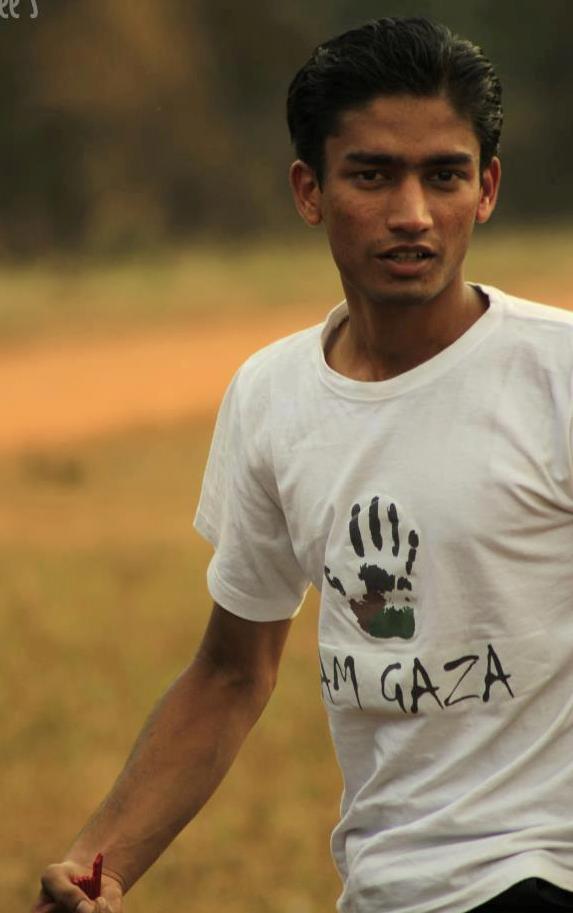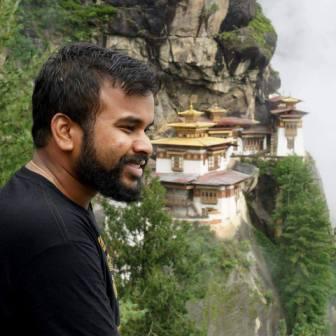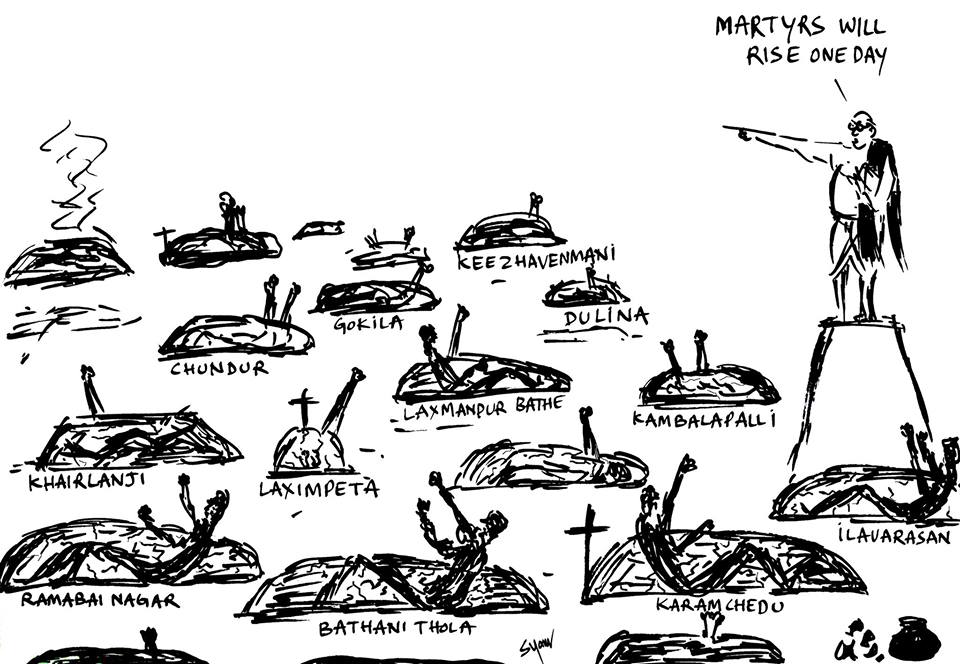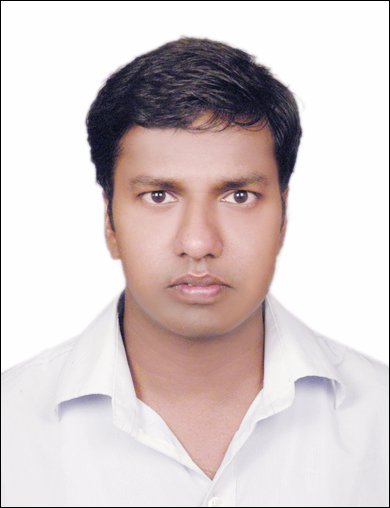Thahir Jamal KM
 On 29th of April, the whole non-teaching staff along with some students started agitations in front of the administrative block demanding compensation for the deceased contract employee, who fell down from the fourth floor of the academic block of EFLU. All of a sudden, around 200 armed policemen rushed into the university with tear gas shells, water cannons and loaded guns and started lathi charging without any provocation. Tear gas machines were aimed towards the hostel, so the students wouldn’t be able to take refuge in their rooms. All 35 acres of EFLU was then nothing but an open prison. Adding to the trauma of administrative discrimination, students felt completely alienated and insecure from what was home for the semester. It is with this police that our honourable VC madam assures security and safety on the campus!!
On 29th of April, the whole non-teaching staff along with some students started agitations in front of the administrative block demanding compensation for the deceased contract employee, who fell down from the fourth floor of the academic block of EFLU. All of a sudden, around 200 armed policemen rushed into the university with tear gas shells, water cannons and loaded guns and started lathi charging without any provocation. Tear gas machines were aimed towards the hostel, so the students wouldn’t be able to take refuge in their rooms. All 35 acres of EFLU was then nothing but an open prison. Adding to the trauma of administrative discrimination, students felt completely alienated and insecure from what was home for the semester. It is with this police that our honourable VC madam assures security and safety on the campus!!
By this time, I had just woken up from my facebook delirium to view the real ground situation. Witnessing the violent nature of the police and their use of abusive words, I thought of recording visuals of the action. I obtained a camera from my friend. Within moments, policemen notice my camera and rush towards me, shouting: “yes, he is having the camera”. They not only grabbed the camera, but they also packed me up in their armed hands. Soon my friend was by my side, offering explanations to the police: “He was just taking photographs. Why do you want to take him?” Without much ado or clarification, my friend was also shoved into the police van. Later from their queries and explanations, I understood that they caught me, suspecting that the camera was Dalit Camera. For the first time, I learned that taking photographs of Indian state’s actions is an act of crime, inviting police action in Indian democracy. Moreover, I experienced the working mechanisms of the Indian state through its administrative apparatus.

The author and fellow student being arrested
EFLU administration has already permitted periodic police patrol to check ‘unauthorized intruders’ into the university. The reason offered being the security and safety of students in the university and hostel premises. Now the question is who will provide safety and security to students from police action? Counting the past experiences of Dalit-Muslim communities with the police in the Indian state, there is no way to trust the police. Rather there is enough reason to suspect police intrusion as a threat to the security of students from these communities. IB officials accompanied by local police and hostel office workers were seen sitting in front of students’ rooms for hours in search of a Muslim student from Kerala. The growing links between the admin and police are no more a secret. The Vice Chancellor has fallen to the position of a military secret cell agent recruited to safeguard saffron nationalism in the name of national security.
Usually, the university spaces and campuses are seen as miniature replicas of society or even the nation itself. The aspirations of campuses are valued on a similar basis, because they seem to prepare the future generation. But the type of campus that is allowed to replicate the status of the nation upholds only certain kinds of youth aspirations and it usually hesitates to question the hegemonic satus quo of the nation. Post Mandal-Babri upsurge among the Dalit-Muslim communities compelled our universities to incorporate these (once excluded ) communities. Within these last two decades the socio-political aspirations of these communities are much evident in the university spaces. It is in this context, one has to look into the suicides and dropouts that are invisible in the legacies of meritorious universities.

After two decades of Mandal and Babri, Indian academia ‘reeks’ with compulsive pretensions of inclusiveness and diversity. Questions regarding neo-democratic movements and identity consciousness are not left behind either. Should Dalit-Muslim-Bahujan be allowed to express their socio-political longing in the sacred secular university space? The dominant view was definitely that they should not be allowed to pollute the sacredness and the merit of the institutions with caste tags (as if upper caste tags are ‘normal’ in the public domain). The outcome of the discussions was the recommendations against radicalization of youth on campuses. “We need to identify and address the causes of radicalisation of some of our youth. Very clearly, lack of productive employment opportunities for our young men and women is one factor which aids such radicalisation. Education and skill development opportunities have a major role to play in addressing this problem,” Prime Minister said at the National Integration Council’s (NIC) meeting in September 2011. NIC had then suggested effective programmes to be launched in all educational institutions to annihilate these ‘academic threats’.
They found the root of the ‘problem’ in lack of productive employment opportunities for our young men and women. For them, education and skill development opportunities have a major role to play in addressing this ‘problem’. This ‘problem solving’ is associated with the ‘Brahmin’s burden’ of civilizing and mainstreaming marginalized sections of the society. The recent University Grants Commission (UGC) recommendation directed vice-chancellors of all universities and heads of other higher educational institutions affiliated to it, to keep an eye on any move towards radicalization of youth on university campuses and take effective measures to prevent such attempts. For them, these subaltern uprisings and voices, full of positive and proud assertion are radical enough to overthrow the state and its machineries of democracy. They are right. The voice of the voiceless will turn upside down the Brahmanical hegemony practiced both in the academia as well as at political levels. The restructuring put in effect by subaltern movements will demolish all the temples of elitism. But will this destroy the democratic and inclusive space? Do they contribute to or eliminate the atmosphere of debate and critique available in our democracy?

The protests in the Telugu press
Caste works in syllabus designing and classroom structure in different ways. For instance, Indian Blossoms, the core text book prescribed for BA English in Calicut University contains poems and stories from ten different authors. Out of the ten, six hail from Brahmin families (no wonder, Indian blossoms is ‘Brahmin blossoms’)!! Humiliation is not only a visible process, but it also develops from the continuous ‘lack’ of self and identity in the surroundings, where one survives. Academic humiliation of students from backward communities arises out of the ‘lack’ of fellow community mates and ‘lack’ of their intellectual figures in the textbooks/syllabus.
Undoubtedly, caste, community and region still hold reign in the interaction between the teacher and student. The moment such identities are visible in the public, the discrimination starts as (they’re identified as) ‘reserved’ or ‘benefitted students’ (reservation in trains is a privilege, but in universities it is charity!!). ‘Benefit’ turns out to be the tag that marks out a student as imperfect or ineligible and haunts him throughout his campus life. Visible community tags such as a Muslim name or headscarf are often symbolised as ‘improper’ for academic excellence. In the long run, to achieve ‘excellence’, these communities will be thrashed back and the blame and burden will be heaped upon their community problems. Instead of merely analysing the community hindrances, one has to look into the exclusive nature of our academic sphere in embracing these communities. A Kashmiri student is a fruitful site of potential threat to the sovereignty of our nation. He is always considered as an irritating parasite living on the normal and disciplined bodies of nationalised students.

Police officer taking pictures of banners
The obvious caste tags in upper caste names are not regarded as a threat to the democratic secular space. But the assertion of caste by a Dalit as a means of resisting the dominant is seen as a major threat to public safety and their body (corporeal presence) is perceived as a contagious site of anxiety. Their body and body caricatures remain a hindrance at the gates to the realm of modernity. The influential intelligentsia will detect the threat on the incapability of backward students to ‘compete’ or integrate themselves into the national sovereignty and not on the system that lacks the culture and initiative of an inclusive nature. Those who resist this monopolizing of culture will be framed as fundamentalist, barbarian, or Maoist sympathizer. The profiling of 18 students and faculty from EFL University after the continuous protest on Mudasir’s death is worth mentioning. Ravichandran, a PhD scholar from the Dalit community, was termed as ‘fundamentalist’ in the police report allegedly provided by the university admin. Initially, the ‘fundamentalist’ tag was given to Muslims alone, but now it reflects a broader paranoia. It addresses anyone, who on any terms, questions the power of the ruling state. In other words, these branded tags are another way of controlling the ‘population’ and taming them to be ‘good citizens’.

Under police siege
A Senior Professor like K.Satyanarayana was branded as the son in-law of a Maoist leader and Maoist sympathiser and Susie Tharu’s only crime seemed to be her advancing age. By inviting police action on students and workers including aged women workers, the administration has proved their inability in dealing with the issues inside the university space. Recently, serious criminal cases have been booked against some 9 students (all from SC/ST/OBC communities) on charges of disrupting the functioning of the university and obstructing police duty. The administration seems reluctant to respond to RTIs filed by students that demand the publication of financial accounts and other related transactions taking place within the purview of the Vice Chancellor. This marks the permanent defeat of a university administration in confronting academic debates, arguments and questions raised by students, especially those who are discriminated within departments, in a democratic manner.
The ongoing protest in the EFL University spurred by the death of Kashmiri Muslim research scholar Mudasir Kamran is one to be counted in the history of student activism. Fighting multiple powers at various levels, EFLU Struggle Committee for Justice for Mudasir is still active in its third month of the protest, taking up various other related issues. The hard work of students, both through legal ways and street protests, in the hot Hyderabad sun compelled the Andhra Pradesh High Court to register a suo motu case on recent suicides in universities in Hyderabad and ask the UGC to enquire into the suicides in universities. These are the visible victories of the protest.

The Vice-Chancellor with her security detail
Now, what one can’t any longer see on crossing the EFL University gates are the agitating walls echoing unanimously for Justice, quoting Dr. B.R Ambedkar, Malcom X, Martin Luther King, etc. Very recently, the EFLU ‘family’ cleaned up the campus walls in attempts to remove traces of our struggle. But faded lines and graffiti persist as voices of a continuing history. The walls spoke of the tremendous protest witnessed and incalculable degrees of labour from the student community. These walls deliberately questioned our humanity, if at all left in the inner corners of our souls, “If death can’t move us, nothing can”. A few steps further, you can’t stop emotions unexpressed as they argue, “Solidarity is the political name of love”.
~~~
Thahir Jamal KM is from Malappuram, Kerala, and is pursuing MA English at English and Foreign Languages University, Hyderabad. He completed his BA English with Journalism from University of Calicut, Kerala.










